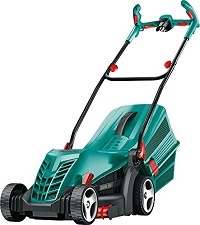Edwin Budding’s original lawn mower design was very much seen as an upgrade to the scythe, and he did his best to try to mimic its slicing action to great effect with the development of the original cylinder mower design. For the first 70 or 80 years of its life the cylinder mower was the king of lawn and park maintenance regimes everywhere, being as it was a tool for the privileged classes, and groundskeepers of sports clubs.
In the years after World War Two there was something of a global consumer explosion, suddenly people found themselves able to afford more luxurious commodities the likes of which they had only been able to dream about previously, and with this ever-increasing demand something needed to change as far as the lawn mower was concerned.
The trouble with cylinder mowers was, and to a large extent still is, that they were a precision tool, far too expensive in almost every regard for the common man to be able to afford. A cylinder mower also requires a much higher level of maintenance and more regular adjustment to a rotary mower, but perhaps the single biggest nail in its coffin from the point of view of your average man in the street was its ineffectiveness on long grass, and therefore the necessity to use mow regularly. The need to mow at the very least on weekly basis during peak season was simply no longer practical with longer working hours and a busier pace of life.
The Rise of The Rotary Lawn Mower

Clearly something was needed for the modern man (or woman) who had everything except a lawn mower to suit his/her wallet and hectic lifestyle, and the rotary lawn mower was the answer. It wasn’t until technology allowed petrol engines to be light and powerful enough for the rotary mechanism to work effectively that the first rotary mowers emerged in the early 1950’s, but when they did it marked a revolution in the modern gardening era. No longer was keeping a neatly trimmed lawn the prerogative of the wealthy, anyone could now own a lawn mower, and they could cut their grass quickly, and as frequently or infrequently as they wished. Thanks to a simple and rugged design, rotary lawn mowers proved their worth largely because the need for regular maintenance was eliminated, if you wanted to you could almost get away with never sharpening the blade, although in time the quality of your cut may have diminished.

The basic principle of a rotary mower is simple, instead of an array of blades that turn in the same direction of the wheels, cutting against a fixed blade like a pair of scissors, the blade instead rotates like a fan with its axis at a right angle to the axis of the wheels. Instead of shearing against another blade, the rotary blades is sharp enough (and moves fast enough) to cut the grass unaided, which although it must be said doesn’t always give such clean results as a cylinder mower, but in truth only real enthusiasts are able to make the distinction.
Rotary Mowers Today
Since the dawn of the rotary lawn mower the industry hasn’t really looked back, today rotary mowers dominate the market, and whilst there are of course constant innovations and improvements, the basic concept remains largely the same. Whether the mower is wheeled or hovers, is driven by a petrol engine, or electric motor, it’s fair to say this type of lawn mower will continue to dominate the market for some time to come, and it won’t be until such time that robotic lawn mower technology becomes an affordable norm that this is ever likely to change.


